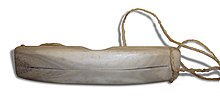Snow blindness
| Classification according to ICD-10 | |
|---|---|
| H16.1 | Other superficial keratitis without conjunctivitis |
| ICD-10 online (WHO version 2019) | |
Snow blindness is known in medicine as actinic keratopathy or photokeratitis . The cause is damage to the outer cornea of the eye from strong UV radiation . In particular, the high energy and short-wave UV-B - radiation is very dangerous.
To protect the inner eye, the surface of the cornea is able to absorb a large part of the harmful radiation. If the radiation is too strong, similar to normal skin, sunburn-like burns of the cornea and conjunctiva occur , which in severe cases can destroy and detach their outermost layer. In these cases, nerve endings are then exposed , which leads to severe pain , extreme sensitivity to light, tearing , red eyes and a feeling of foreign bodies in the eye.
Actinic keratopathy can occur not only on snow ( reflection of UV radiation) or at great heights (where natural absorption by the earth's atmosphere is reduced), but can also be caused by artificial UV radiation ( sweat - electric arc , UV lamps ) become.
In milder cases, actinic keratopathy heals without permanent damage in two to three days, in more severe cases and especially without medical treatment, irreparable visual damage can remain due to scarring of the cornea and damage to the retina .
As immediate measures, darkening and cooling the eyes with a damp cloth are recommended. Medical treatment is essential.

